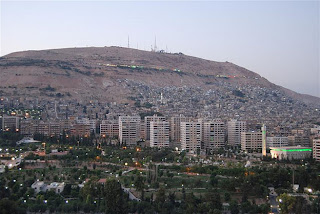“What we build – where and how – has a tremendous impact on how we sustain our communities, protect the environment and bolster prosperity.” 1
My trip to Syria first started with the snow storm mess in Europe where I, like many other travellers, had to connect through different airports to reach my destination – Damascus.
Photo Credit: Samer Kallas
When I arrived in Damascus in the morning, I had to get through the city’s usual rush hour - it was a stressful 30 minute journey. The chaos, danger and pollution that those thousands of vehicles bring to the city’s streets is unacceptable, especially in a city struggling to show its beauty.
The absence of any rules that organize and manage the numbers of vehicles on the streets is stunning. One day, in the very near future, street movement of Damascus, Aleppo, Homs, Lattakia and many other major Syrian cities will come to a standstill. Unfortunately, this dark reality will only become much worse if we don’t take responsibility and deal with this problem today. Even now, we are already too late.
Photo Credit: Emad Al Sagheer
Undoubtedly, we have no other choice but to try and stop the increase in daily use of private motor vehicles just so our city’s streets can breathe again. It will be extremely difficult, however, if it’s done, we can return our public spaces to places of movement, experience and public activity.
In my humble opinion, what Damascus is missing is a comprehensive integration of Land Use Strategy and Transport Planning. This will help reduce the growth in car numbers and car use, which, consequently, will reduce street congestion as well as air, noise, and visual pollution. Land Use Strategy is the most important planning instrument for any city to create the image it wants, while Public Transportation, Walking and Cycling, Parking Policy and Traffic Management are the main elements of the Transport Planning system.
The main objectives of integrating Land Use and Transport Planning are to:
- Promote the long-term investing strategy in public transportation projects
- Promote the use of public transportation by increasing Land Use density and mixed uses around transport nodes and corridors
- Encourage people to reduce car dependency
- Promote developments that support sustainability, walking, cycling and public transport use, like Smart Growth and Transit-Oriented Development TOD
- Management of traffic and parking in city centres and popular spots.
“Mayor Mockus defined the culture of citizenship as “the sum of habits, behaviours, actions and minimum common rules that generate a sense of belonging, facilitate harmony among citizens, and lead to respect for shared property and heritage and the recognition of citizens’ rights and duties.” 2
The main goal of the integration process is not to abolish vehicles in our city; it’s more about targeting bad habits that have substantial effects on our public street life and managing those habits to a point where we, the human, can have our spaces. This is why it’s so important for citizens to take part in the solution and become full partners in their neighbourhood’s development process. Secrecy and ambiguity regarding planning for people’s neighbourhoods, communities, and cities has never been a solution. It didn’t work yesterday and it definitely won’t work today or tomorrow. Communication and engagement is a must.
Commitment in implementing and monitoring a plan is another necessity in order for progress to happen. The strategy should be reviewed annually for evaluation and revision.
In addition, the environment is not presented here as having a separate element in the integration process; rather, it is highly dependent on the success of a plan. Every positive change we make in the transport system of a city, regardless how small, will have major consequences on its environment. A cleaner and healthier environment is a sign of a working strategy. The greener we are the more we protect our children’s future and make our cities good places to live in.
Photo Credit: Samer Kallas
There are no magic solutions -- it’s hard, it takes time, extensive research, a great deal of experimenting, monitoring, and rules, and large amounts of money. It needs everyone’s engagement if we really want our city to become a better place to live in.
Up next:
The main Transportation Planning elements we need to integrate in the Land Use Strategy: Public Transportation, Walking and Cycling, Parking Policy, and Traffic Management.
1- Kooshian, Chuck. Winkelman, Steve. Growing Wealthier; Smart Growth, Climate Change and Prosperity, Center for Clean Air Policy, January 2011.
2- Montezuma, Ricardo. The Transformation of Bogota, Colombia, 1995-2000: Investing in Citizenship and Urban Mobility. Global Urban Development Magazine, Volume1, Issue1, May 2005.


